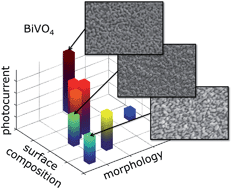Factors affecting bismuth vanadate photoelectrochemical performance†
Abstract
Bismuth vanadate is a promising photoanode material, but recent reports on undoped BiVO4 without sublayers and co-catalysts showed large variations in photocurrent generation. We addressed this issue by correlating photoelectrochemical performance with physical properties. We devised a novel anodic electrodeposition procedure with iodide added to the aqueous plating bath, which allowed us to prepare BiVO4 photoanodes with virtually identical thicknesses but different morphologies, and we could control surface Bi content. Morphologies were quantified from SEM images as distributions of crystallite areas and aspect-ratio-normalised diameters, and their statistical moments were derived. We could obtain clear photocurrent generation trends only from bivariate data analysis. Our experimental evidence suggests that a combination of low Bi/V ratio, small aspect-ratio-normalised diameters, and crystallites sizes that were small enough to provide efficient charge separation yet sufficiently large to prevent mass transport limitations led to highest photoelectrochemical performance.


 Please wait while we load your content...
Please wait while we load your content...